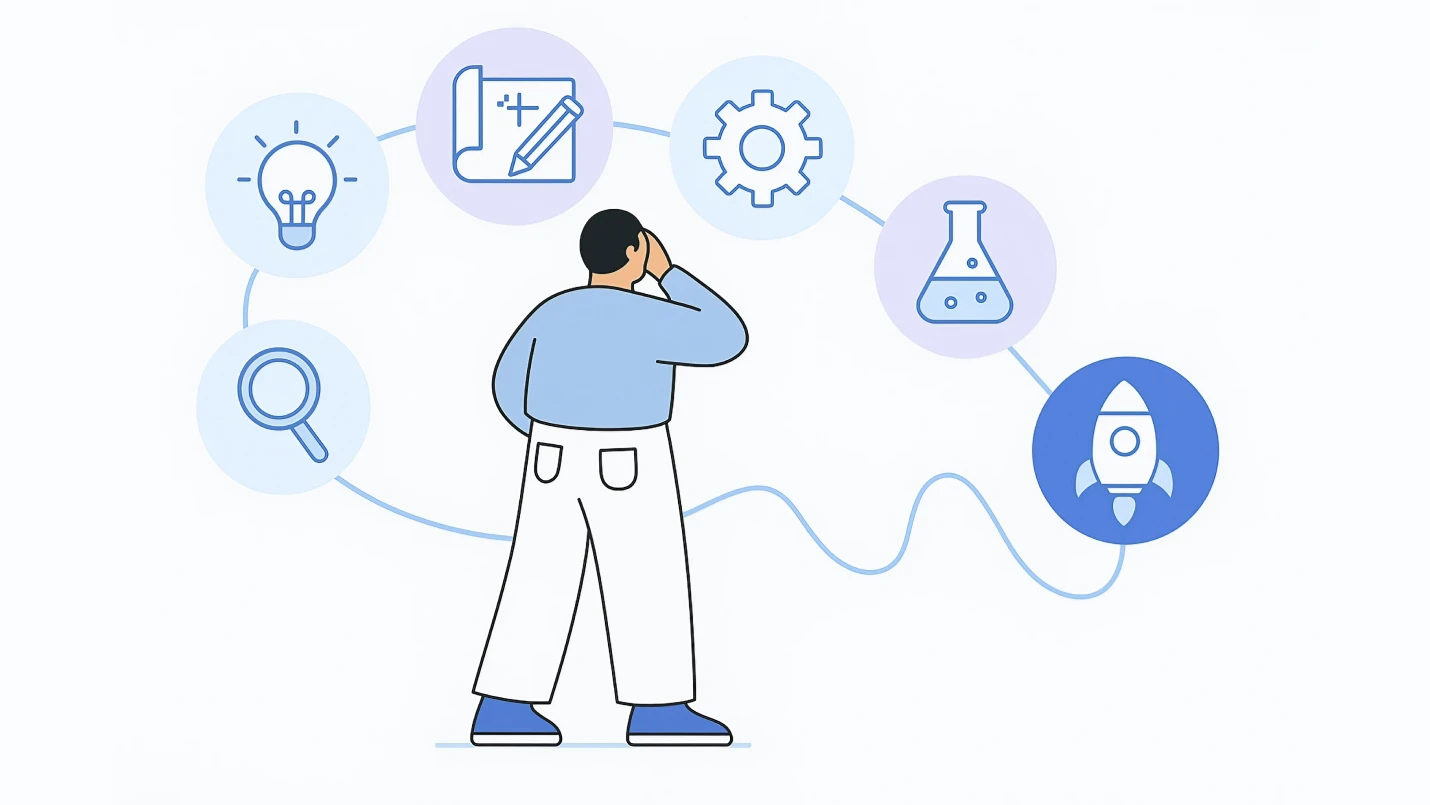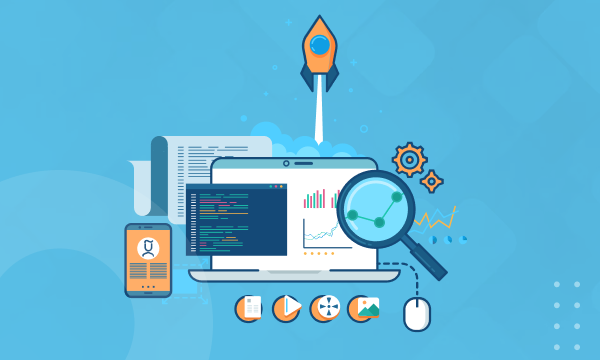According to Statista’s survey (n= 544), 29% of tech companies planned to focus on new product development post the onset of COVID-19. Considering the impact of COVID-19 on businesses, the R&D efforts around new product development have increased. While some tech companies focused on launching new products, others improved the existing digital products.
The secret sauce for new product development’s idea success is simple — focus on product discovery and address the pain points of the target audience. This is why it is essential to gather customer insights through customer surveys, interviews, monitoring social media interactions, and ethnographic research.
Moreover, product discovery should be an ongoing process. It should continue over the product life cycle stages, i.e., idea generation, idea validation, validating PoC and prototype, MVP development, pre-launch, and post-launch. In other words, product discovery should continue throughout the product’s lifetime.
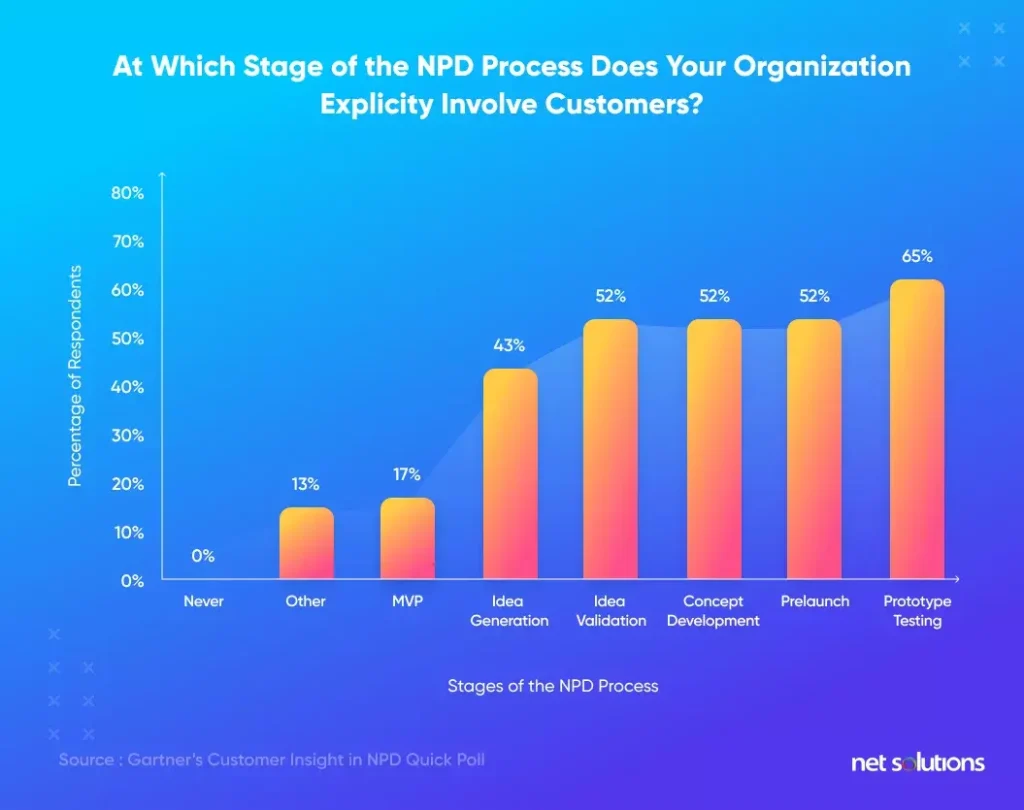
What are the new product development stages? This piece is a detailed walkthrough of the process.
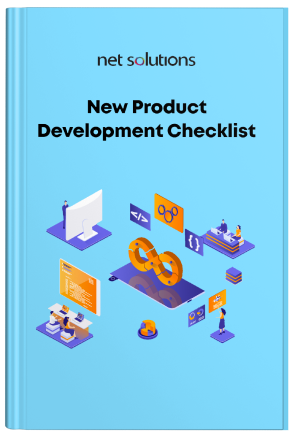
We respect your privacy. Your information is safe.
What is New Product Development (NPD)?

New product development is the process of converting an idea into a workable software product.
The New Product Development (NPD) process is about grabbing the market opportunity that revolves around customer needs, checking the idea’s feasibility, and delivering working software.
On the other hand, Product Development is an umbrella term that sticks to the six stages of software development lifecycle and works on launching products that already have a Proof of Concept (POC). The New Product Development approach revolves around working on an entirely new idea, where the uncertainty around its development and subsequent adoption is high.
Some of the successful New Product Development examples include — Trello for task management and tracking, Zoom for video communication, Dropbox for cloud storage, Figma for designers working remotely, Airtable for relational data management, and so on.
Here is an insight into each of these stages for understanding how to develop a new product:
Seven Stages of New Product Life Cycle Development Process
Building new products and services can be a process filled with uncertainty. However, following the systematic New Product Development process can help businesses gain clarity and confidence in what they are building.
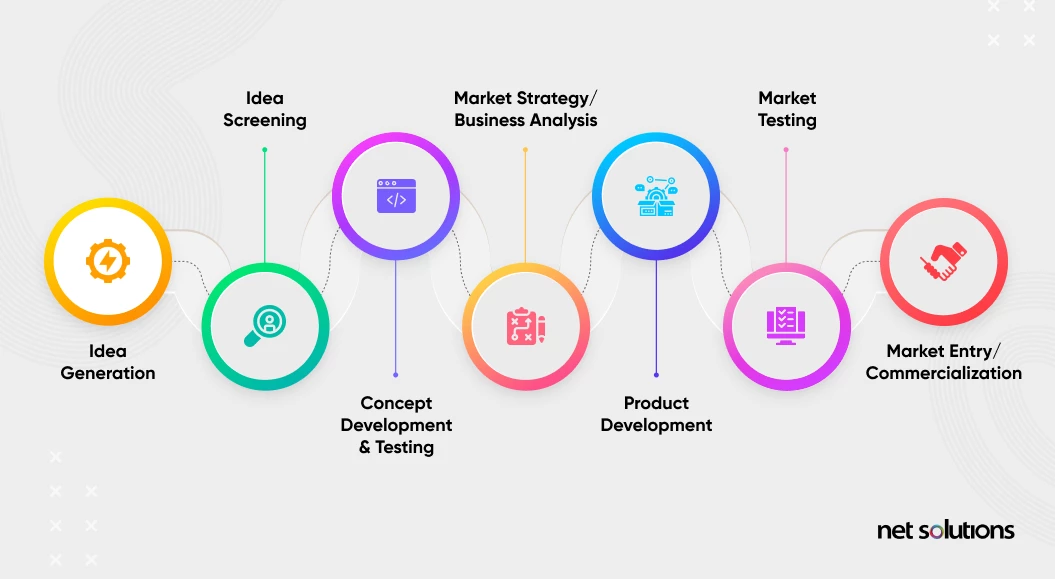
Stage 1: Idea Generation
The goal should be to generate many worthy ideas that can form the foundation for the New Product Development strategy. The major focus for stage 1 should be to arrange brainstorming sessions where solving customer problems is given precedence.
This phase is not about generating foolproof ideas that are ready for implementation. Instead, raw and unproven ideas that can be shortlisted later should be discussed.
Here’s how a business can do that:
1. Emphasize on Customer Problems
The problem that is well described is a problem half-solved. Here’s how to identify the issues that the target audience is facing:
a. Personal Problems
It is a good idea to look at problems the business is facing to come up with the idea. All a business needs to focus on that specific problem and build a solution that can be tagged as a “one for all” solution to the common problem.
To start with, a business needs to understand the human story behind digital offerings.
For instance, Jeff Lawson, the founder of Twilio, has an interesting story behind its communication-based software product launch.
He was associated with three business companies in the past, and all of them lacked one thing — Productivity.
When he was driven to start again with something of his own, he knew that he needed to cover up the communication gaps as these were, in his experience, the biggest hurdles on the path to productivity.
That is when product innovation happened in the form of Twilio. The product building and launching had their ups and downs, but his conviction to have this product led to a great business idea.
Here is an inspiring extract of his speech from the Web Summit.
b. Qualify Each of the Listed Problems
This step helps check the feasibility of the shortlisted problems and their solutions based on the 4U approach by Michael Skok, the founder of Startup Secrets. The 4U stands for:
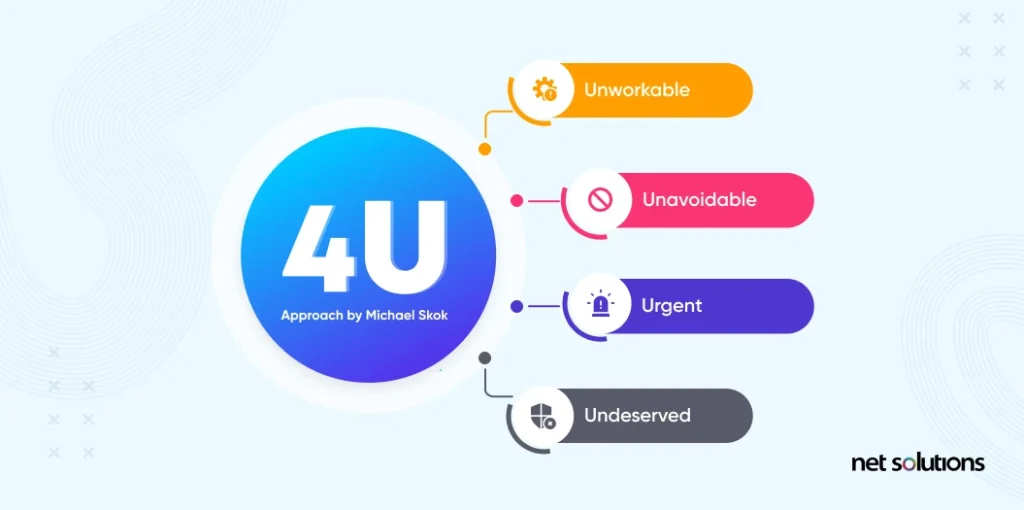
Taking a deeper look at each of these aspects in detail will provide greater clarity.
- Unworkable: Figure out whether the brainstormed product concepts will address some real problems. Will the product be able to fill the existing customer experience gaps and will the product achieve product-market fit?
- Unavoidable: Is the problem the product will address unavoidable to the extent that it becomes mandatory to comply? It is necessary to find out whether solving that problem is a choice or a compulsion.
- Urgent: Is the problem urgent and is a solution highly demanded by the target market? If the answer is affirmative, this could be a chance to cover the white space in the market with the original product.
- Underserved: Are there no available products that address the existing user problems? Look for the whitespace in the market and hold on to the idea that looks promising.
c. Coming Up With Possible Solutions
If a problem has been identified, it’s time to look for possible solutions. For every user problem, there ought to be potential New Product Development opportunities.
Here’s the workflow that starts with a problem and ends with strategizing around the solution.
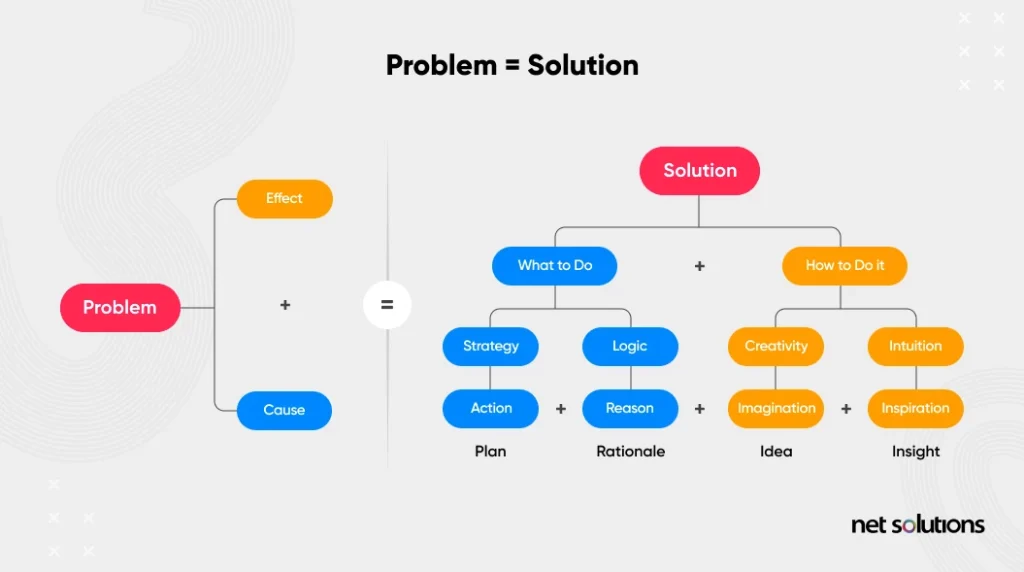
In all, no matter how common or uncommon the problem is, the solution should be unique. Even if a product already exists, ensure that the product can solve problems differently.
For instance, Slack and Zoom are both SaaS products that focus on promoting communication and collaboration. Zoom, however, does this differently by also enabling the conducting of webinars. In other words, webinars are their unique selling point (USP).
d. Narrowing Down Problems + Solutions
Create a comparison chart that lists all the shortlisted problems and solutions. Circulate the findings across the organizational structure to develop a viable problem set.
If the stakeholders are not convinced regarding the shortlisted idea, try the Replicate, Re-Purpose, and Upgrade approach.
- Replicate: This focuses on creating a similar product as that of a competitor but launching it in new market conditions. When done with launching the minimum viable product (MVP), the strategy should be to expand the business by introducing out-of-the-box and unique features later on.
- Re-Purpose: This focuses on rewiring an existing business model. For instance, LinkedIn introduced LinkedIn Learning, an e-learning platform for professionals. This product was similar to an e-learning platform for students. However, they built new opportunities for expanding the target audience and market share.
- Upgrading: This concept of New Product Development revolves around introducing a new business model that is better than existing solutions. Better could mean improved performance, better speed, addressing the challenges that a competitor is facing, or introducing added functionalities.
Stage 2: Idea Screening
This New Product Development stage revolves around choosing the one idea with the highest potential for success. Put all the ideas available on the table for internal review. That is, turn to people with industry knowledge and experience in the field for idea screening.
A proof of concept (POC) should hold precedence for a new product development idea as it helps check the idea’s feasibility. There is no point in zeroing in on an idea that is not technically feasible to build.
Consult the Agile Development team. Their expertise can help with understanding the technical side of things, which, in turn, can assist with shortlisting ideas worth building a PoC for.
SWOT ( Strengths, Weaknesses, Opportunities, and Threats) analysis can be another good practice to consider when shortlisting New Product Development ideas.
In a SWOT analysis, the Agile Development team, the product owner, the scrum master, and the product manager conduct a detailed analysis of the idea to identify an idea where strengths and opportunities overpower threats and weaknesses.
Conducting a SWOT is relatively simple. Getting started only requires a simple 2×2 grid:
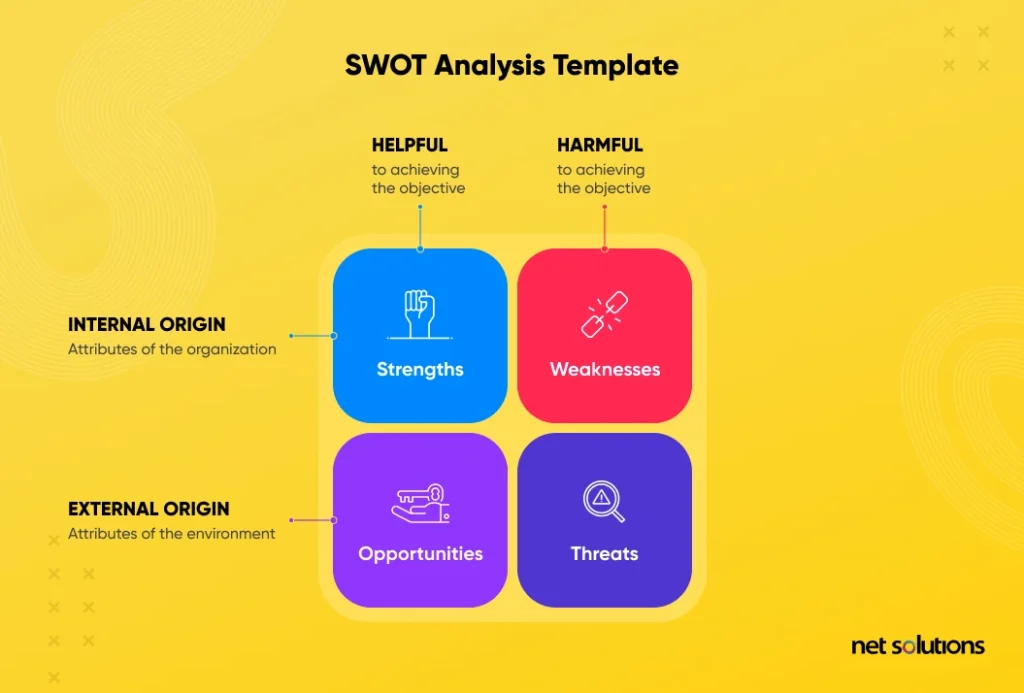
In conclusion, the New Product Development idea should be unique so that people do not need to be convinced to pay for it.
Stage 3: Concept Development & Testing
Before starting the New Product Development process, building a detailed version of the idea and the user stories should be prioritized.
This value proposition evaluation is the first step towards concept development and testing. At the very least, it ensures that problems in the approach are discovered sooner and the team can course-correct earlier. That helps to ensure that technical debts will not accumulate.
There is a 17% chance that [your] startup’s idea fails, just because it was a poor product. — CBI Insights
The easy-to-follow concept development steps include:
1. Quantifying Gain/Pain Ratio
A business needs to create an insightful picture of the product from the user’s perspective. This can be achieved by calculating the gain/pain ratio, where:
Gain = Benefits of the product for the customer. What is in it for them?
Pain = The efforts made by the customer to understand and use the product.
2. Conducting a Competitor Analysis
Knowing about existing market players is a critical strategic step to consider. Understanding the competition makes it easier to infer:
- Where the competitor lacks
- Where is the scope for improvement
- Existing white space in the market
3. Enlisting the Major Product Features
The user stories involved in the New Product Development software project will make or break a business. When creating a list of such features, it is imperative to know — how is it an innovative feature, and how is it going to solve a problem?
4. Create a Value Proposition Chart
Even after being convinced of the wisdom & the utility of an idea, being able to state it clearly to the end-user, in their context, is quite a different story altogether. The end-user needs to be given a clear picture of what the new product is capable of doing.
This clean & presentable fashion can be best represented in the form of a value proposition chart. The format of which should include:
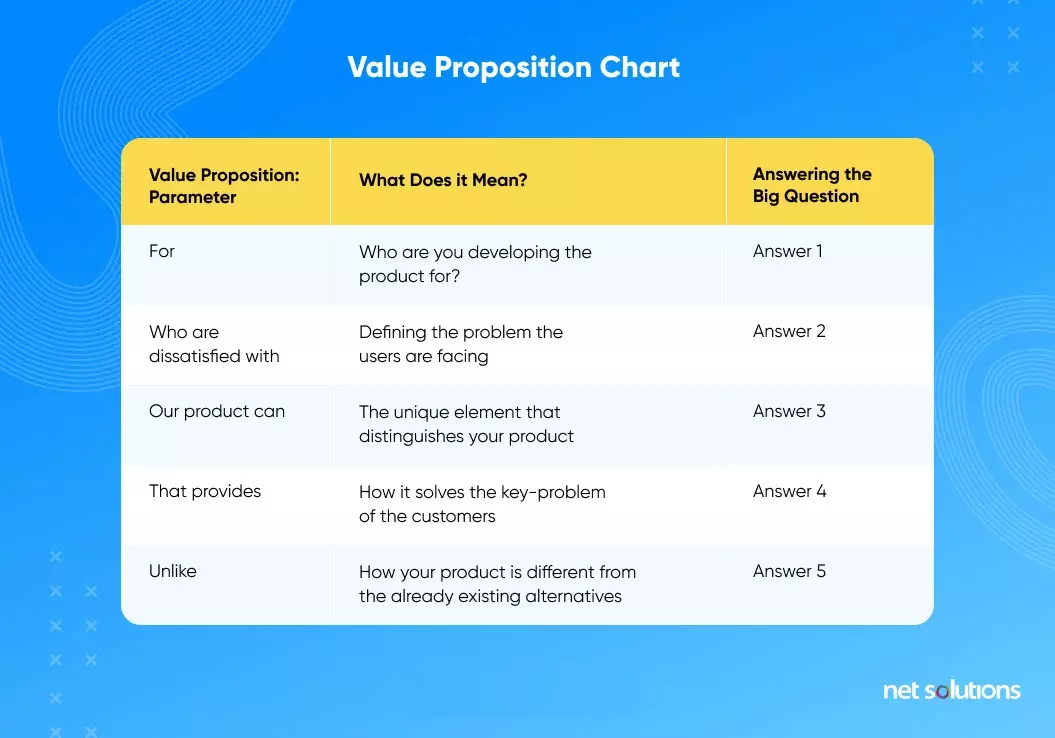
5. Concept Testing
Once the value proposition is ready, it is time to present it to the set of selected customers. How they perceive the idea is the test of the efforts so far. If the idea doesn’t look promising, it is wise to repeat the idea screening steps to develop a new product.
Meaningful insight can be gained by focusing on four critical aspects:
- Identification of the focus group, i.e., people who would benefit from the new product under development.
- Assessment of other alternatives that can be presented to the focus group.
- Development of a foolproof plan for the New Product Development that includes all stages from feature development, marketing, pricing, and distribution.
- Positioning of the product’s unique features into the customers’ minds to enhance findability and discoverability.
The concept testing report would look something like this:
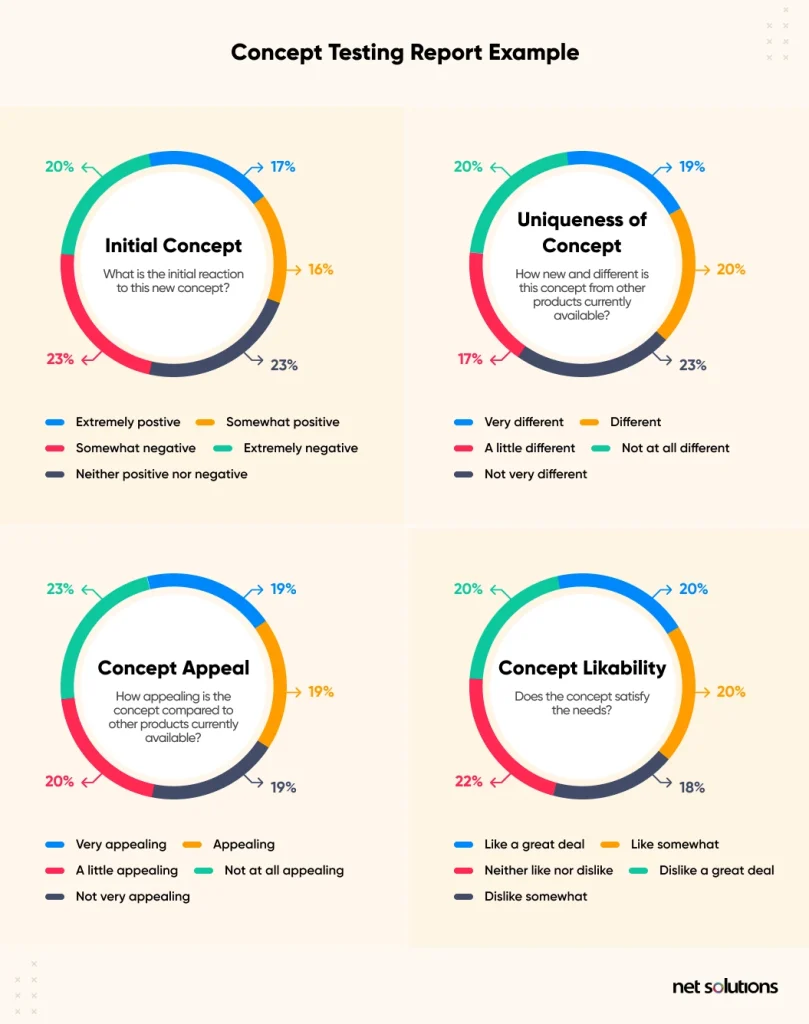
Stage 4: Market Strategy/Business Analysis
Marketing strategy is all about drafting a way to reach out to the targeted audience. Perhaps the best and most straightforward method is to follow McCarthy’s 4Ps of marketing for a New Product Development project.
| Product | Finalizing the software product based on the concept testing report | Product Design
Branding Strategy Level of services offered |
| Price | Strategizing around product licensing cost, estimating profit margins, and creating an unbeatable marketing strategy | Pricing Strategy
Discounting Policies Payment Modes |
| Promotion | Distinguishing the new solution from others by highlighting the hero point or unique feature | Balancing advertising, marketing, and public relations strategy
The mediums to reach out to the target audience Maintaining a fair to-and-fro customer communication frequency limit |
| Placement | Communicating how it solves the key problems of the customer | Finalizing product distribution strategies
Defining the product’s scope, i.e., local vs Global |
This business analysis will help to determine whether the New Product Development efforts are worth the financial investment or not (i.e., will it create a continuous stream of value)?
It is important to strategize in an informed way about the selling price by identifying the base price of the product. The best way to identify the base price is:
1. Cost-Based Pricing Model
Here, the initial production cost is added to the markup percentage to come up with the new product’s final price.
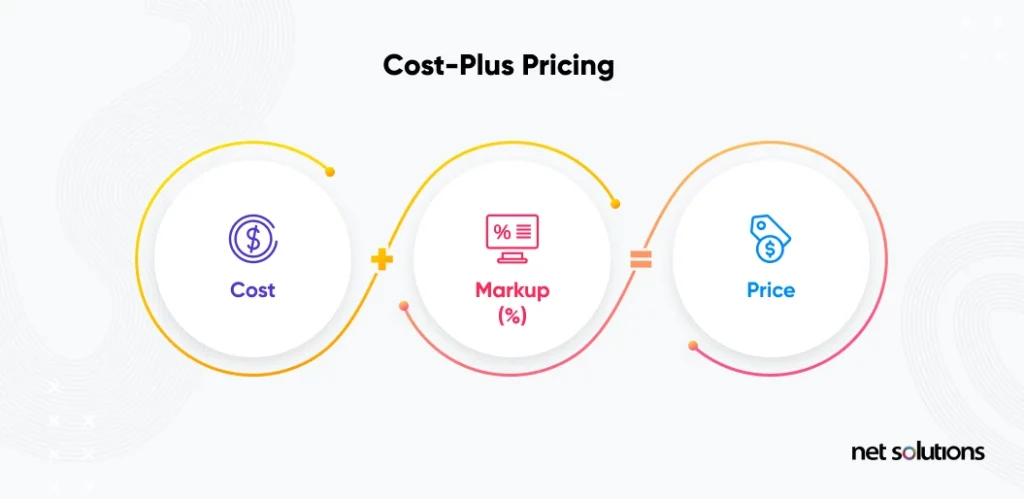
Applying the cost-plus pricing formula:
- Production cost = Technology cost + development cost + licensing cost = $100
- Markup% = 50%
- Price = $150
If a business analysis team applies the psychological price trick (i.e., ending the final price with 5 or 9 digits) chances of conversions increase.
So, if the psychological pricing is to play, the $150 price will become $149.9.
2. Market-Focused Pricing
This pricing is inferred after a thorough analysis of the pricing model of similar products in the target market.
The market-oriented pricing follows the trajectory:
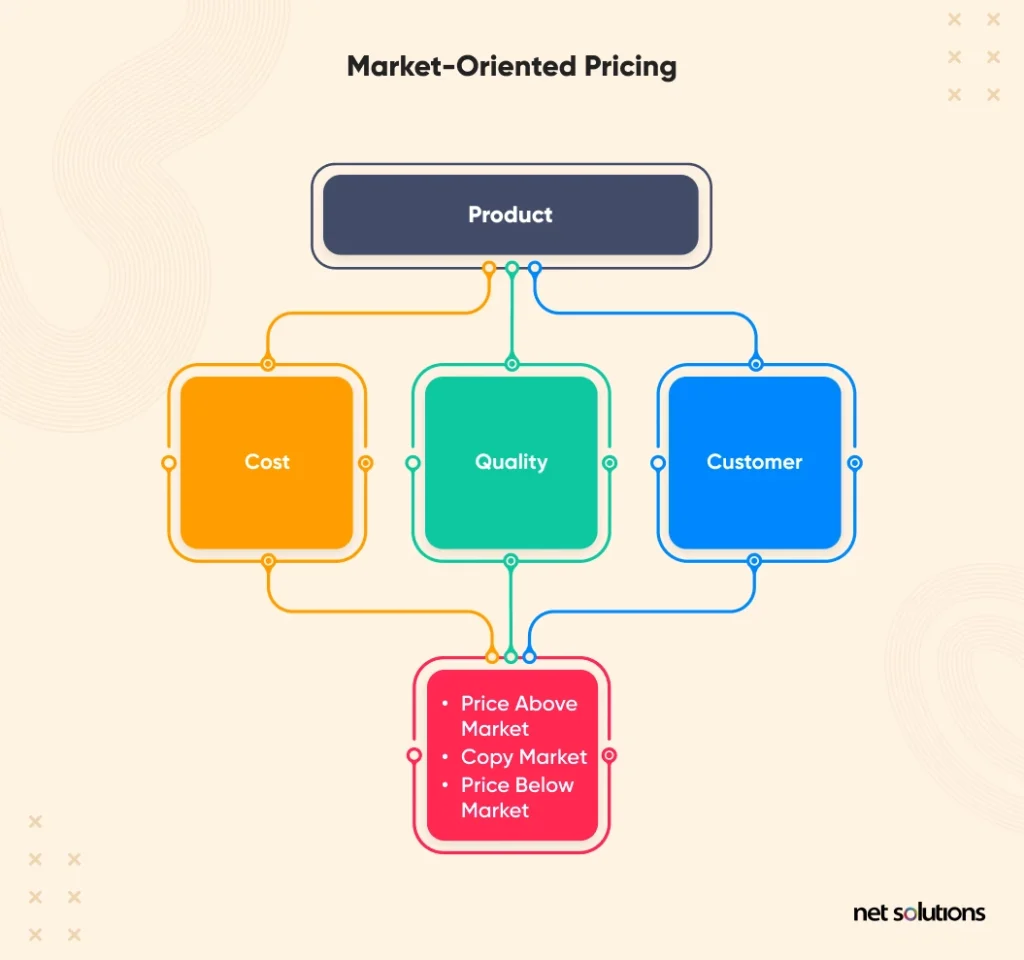
The factors to consider when selecting a competitive price:
- Price Above Market: A higher price is suitable when proceeding with New Product Development initiatives that solve an urgent problem of the customers.
- Copy Market: Selling the new product at the same price as the competitors can initially be a safer move. However, marketing efforts would have to be ramped up to score better than the competitor.
- Price Below Market: A lower price bracket than the competitor is recommended to attract customers that can be converted into loyal ones over time, even if the new product solves things differently.
Stage 5: Product Development
When the New Product Development idea is in place, the market strategy is documented, and the business analysis is completed, it is time to move on with the product life-cycle development process.
The New Product Development starts with developing the prototype followed by MVP.
1. Prototype
This focuses on creating the UI/UX for the product, which is then shared with the stakeholders. This helps in visualizing how the product will look and whether it complies with ergonomics best practices.
2. Minimum Viable Product (MVP)
This focuses on working on the user stories in Agile for the New Product that will set it apart from others. Once the design, development, and testing are done, the MVP is launched in the market with minimal features. The future iterations depend on the initial response.
The best way to approach New Product Development is to rely on Agile Product Development that focuses on incremental and iterative development while promoting collaboration and communication.
This is better than the waterfall approach as it allows for to-and-fro movement across the product development cycle as new user requirements emerge. Though the development stages of Waterfall and Agile are similar, these software development methodologies differ.
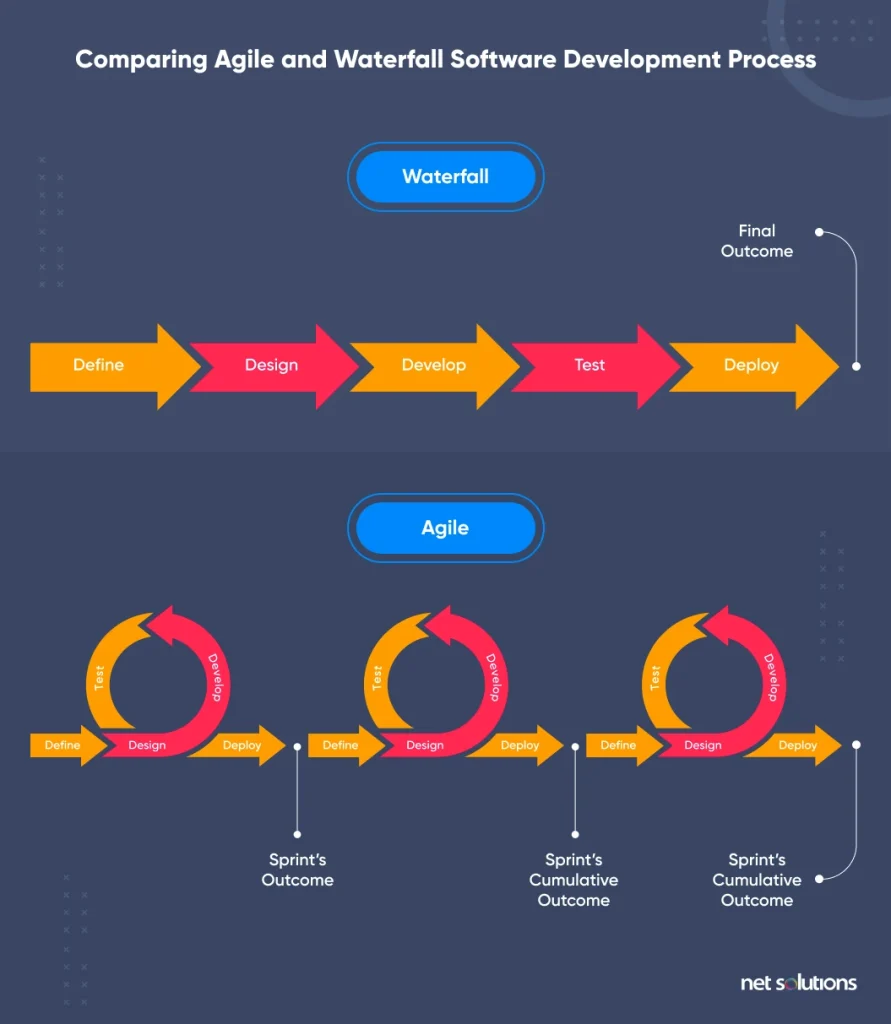
The advantage of Agile is that it speeds up the software development process while maintaining communication and synchronization across the development teams.
Stage 6: Deployment
Once the MVP is ready, efforts shift from development to deploying the product in the live environment. This process involves embracing the DevOps culture and implementing the CI/CD pipeline.
The different stages of implementation include:
a. Commit
This stage involves:
- The newly developed features are integrated with the code for the existing features
- Quality assurance team ensures that the integrated code works fine
- CI/CD tools such as Jenkins run automated unit tests and sanity tests to check code’s efficacy
b. Build
This stage involves:
- Developers push the software artifacts into the registry using Docker tools such as Gradle, Packer, AZK, etc.
c. Alpha Deployment
This stage involves:
- Developers test the performance of the new builds and the interactions between those builds.
d. Beta Deployment
This stage involves:
- Manual testing of the new product to validate its overall performance and efficiency of output considering all input scenarios.
e. Production Deployment
This stage involves:
- The product is pushed into the live environment, i.e., the product is available and ready to use by the end-users.
Stage 7: Market Entry/Commercialization
Commercialization is an umbrella term that entails varied strategies to ensure the success of the new product. Here is what commercialization includes:
If all the mentioned strategies fall right in place, nothing can stop a product from getting attention and being a product-market fit.
Here are some must-do marketing activities that will help the product gain traction:
1. Marketing the Concept Over Product
The idea here is simple: talk about the concept and the product’s intent instead of endlessly boasting about the product features. In short, answer how the product will make the customer’s life easier.
When HubSpot, a marketer’s product, was launched, it was not much of a success. Sadly, their customers did not understand the intent of the now successful product.
So, how did they change the game?
They chose to market their unique selling point instead of marketing and promoting the entire product. That unique selling point was inbound marketing.
They started to create awareness around inbound marketing and instantly became a recognized leader in the software product industry. Sometimes the right marketing is all a product needs for the magnet effect.
2. Having a Brand Voice
A unique mindset and a unique voice always gain an all-ears audience. This is where the marketing team plays a significant role. They need to establish an effective communication style that represents the brand in the best manner.
Be it blogs, emails, or even the website content, all of these elements need to be well thought out and clear in their message. In the end, these elements should hold the power to intrigue the target audience.
3. Conducting Intriguing Webinars
Webinars are one way to attract quality leads. Conduct webinars that talk about how the new product will benefit the audience and describe the features that are being introduced.
Webinars can also help promote findability and discoverability:
- Findability: It is easy to find and use features that the customer is aware of.
- Discoverability: It is easy to find and use features that the customer has no knowledge about.
Now that remote work is gaining traction, webinars are an even more effective way to reach a target audience. Talk about the product, describe its features, and witness a positive impact on the bottom line.
Benefits of the New Product Development Process
Here are some of the benefits of sticking to the New Product Development process:
- Helps check the technical feasibility of the idea
- Ensures faster time to market
- Effectively addresses the customer needs
- Multiplies the chances of success
- Reduces technical debt
- Better management of the feature creep
- Negates the opportunity cost
Frequently Asked Questions
New Product development helps an organization (or a startup) achieve organic growth by creating products that solve real customer problems. Some of the reasons for considering new product development include:
- Meet changing consumer needs
- Launch a product in a new market
- To maintain competitive edge
- To introduce a product based on a disruptive technology
- Help solve a unique customer problem
- Help solve a common customer problem in a unique way
Finding the right idea for new product development can be a challenging task. Here are some of the tried and tested ways for coming up with new product development ideas are:
- Survey customers for understanding their problems
- Identify internal, personal problems that you can solve
- Identify new, disruptive technologies that you can experiment with
- Look for problems that customers face with an existing product (serving the same niche)
There are four types of new product development, which include disruptive, radical, sustaining, and incremental.
Yes, we’ve helped build tens of hundreds of new products in the web app and mobile app space.
Podeum is an example. Net Solutions helped develop Podeum, an innovative EdTech platform.
Canadian entrepreneur Steven Herson’s pain point was that a unified platform for educational material did not exist. This market gap birthed the idea for a new product where every education resource is curated and categorized under respective subjects.
Here’s the case study on how Net Solutions helped Steven build the new product and take it to the market.

